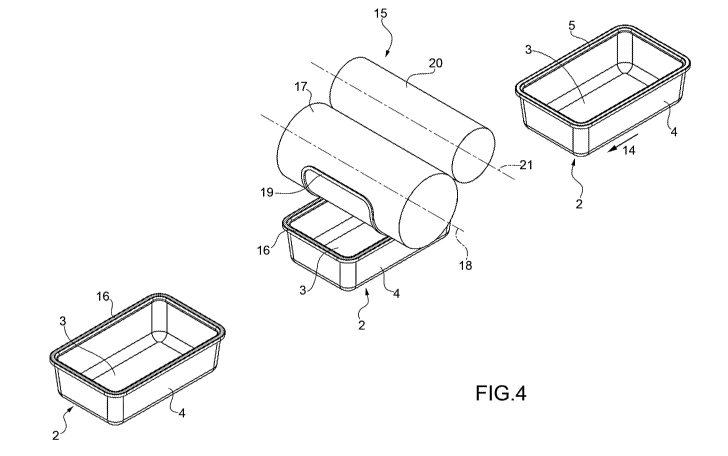Some of the information on this Web page has been provided by external sources. The Government of Canada is not responsible for the accuracy, reliability or currency of the information supplied by external sources. Users wishing to rely upon this information should consult directly with the source of the information. Content provided by external sources is not subject to official languages, privacy and accessibility requirements.
Any discrepancies in the text and image of the Claims and Abstract are due to differing posting times. Text of the Claims and Abstract are posted:
| (12) Patent Application: | (11) CA 3137261 |
|---|---|
| (54) English Title: | CONTAINER FOR FOOD PRODUCTS AND METHOD TO MANUFACTURE IT |
| (54) French Title: | RECIPIENT POUR PRODUITS ALIMENTAIRES ET PROCEDE POUR FABRIQUER LEDIT RECIPIENT |
| Status: | Examination Requested |
| (51) International Patent Classification (IPC): |
|
|---|---|
| (72) Inventors : |
|
| (73) Owners : |
|
| (71) Applicants : |
|
| (74) Agent: | PERRY + CURRIER |
| (74) Associate agent: | |
| (45) Issued: | |
| (86) PCT Filing Date: | 2020-04-17 |
| (87) Open to Public Inspection: | 2020-10-22 |
| Examination requested: | 2024-02-14 |
| Availability of licence: | N/A |
| (25) Language of filing: | English |
| Patent Cooperation Treaty (PCT): | Yes |
|---|---|
| (86) PCT Filing Number: | PCT/IB2020/053663 |
| (87) International Publication Number: | WO2020/212933 |
| (85) National Entry: | 2021-10-18 |
| (30) Application Priority Data: | ||||||
|---|---|---|---|---|---|---|
|
A container for food products is defined by a tray (2), which is made of a polymer material, has a bottom wall (3), a side wall (4), and an upper peripheral edge (5), and is provided with a glue layer (16) directly applied on the polymer material of the upper peripheral edge (5) to lock a closing lid (6) on the upper peripheral edge (5).
L'invention concerne un récipient pour produits alimentaires. Le récipient pour produits alimentaires est défini par un plateau (2), qui est fait d'un matériau polymère, a une paroi inférieure (3), une paroi latérale (4) et un bord périphérique supérieur (5), et est pourvu d'une couche de colle (16) appliquée directement sur le matériau polymère du bord périphérique supérieur (5) pour verrouiller un couvercle de fermeture (6) sur le bord périphérique supérieur (5).
Note: Claims are shown in the official language in which they were submitted.
Note: Descriptions are shown in the official language in which they were submitted.

For a clearer understanding of the status of the application/patent presented on this page, the site Disclaimer , as well as the definitions for Patent , Administrative Status , Maintenance Fee and Payment History should be consulted.
| Title | Date |
|---|---|
| Forecasted Issue Date | Unavailable |
| (86) PCT Filing Date | 2020-04-17 |
| (87) PCT Publication Date | 2020-10-22 |
| (85) National Entry | 2021-10-18 |
| Examination Requested | 2024-02-14 |
There is no abandonment history.
Last Payment of $125.00 was received on 2024-03-26
Upcoming maintenance fee amounts
| Description | Date | Amount |
|---|---|---|
| Next Payment if standard fee | 2025-04-17 | $277.00 |
| Next Payment if small entity fee | 2025-04-17 | $100.00 |
Note : If the full payment has not been received on or before the date indicated, a further fee may be required which may be one of the following
Patent fees are adjusted on the 1st of January every year. The amounts above are the current amounts if received by December 31 of the current year.
Please refer to the CIPO
Patent Fees
web page to see all current fee amounts.
| Fee Type | Anniversary Year | Due Date | Amount Paid | Paid Date |
|---|---|---|---|---|
| Application Fee | 2021-10-18 | $408.00 | 2021-10-18 | |
| Maintenance Fee - Application - New Act | 2 | 2022-04-19 | $100.00 | 2022-03-24 |
| Maintenance Fee - Application - New Act | 3 | 2023-04-17 | $100.00 | 2023-03-20 |
| Request for Examination | 2024-04-17 | $1,110.00 | 2024-02-14 | |
| Maintenance Fee - Application - New Act | 4 | 2024-04-17 | $125.00 | 2024-03-26 |
Note: Records showing the ownership history in alphabetical order.
| Current Owners on Record |
|---|
| SIROPACK ITALIA S.R.L. |
| Past Owners on Record |
|---|
| None |